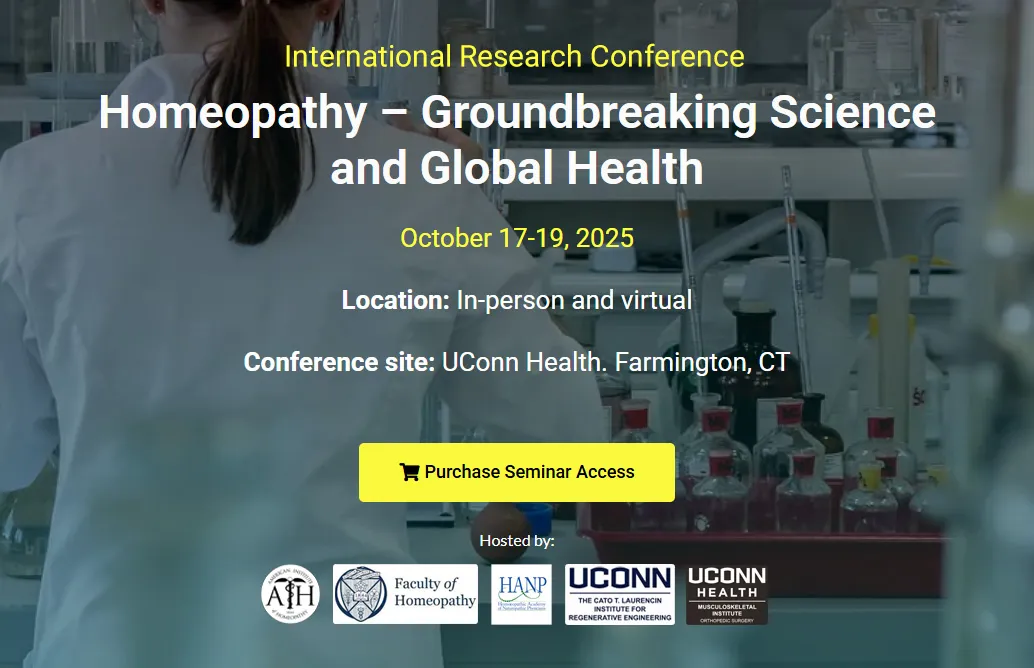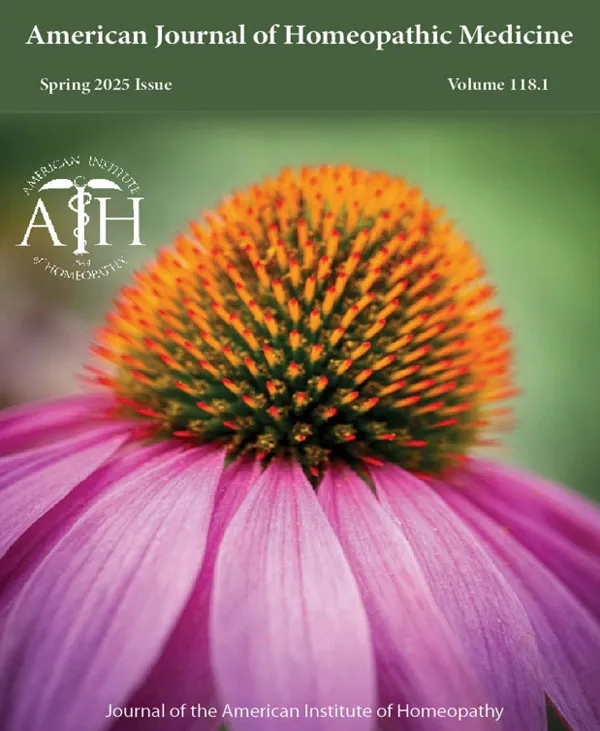
Guest Editorial: From Toxicology to Clinical Application
From Toxicology to Clinical Application:
Our Upcoming AIH Conference:
Highlighting Primary Sources in a New Online Digital Library
Jamie Oskin, ND, DTBRm, DHANP
Abstract: This article will preview an exciting homoeopathy collaborative conference on September 20th, 2024, at Sonoran University as well as highlight the unveiling of a new online open-source library housed at the university that will be freely made available to the profession. We will teach hands-on, active learning exercises to the profession on how to utilize this amazing resource. This article will provide a sample toxicology report from Ipecacuanha cited by Hahnemann and then apply this “picture” to a case successfully treated homoeopathically with same medicine.
Conference and Online Library Preview
The conference is a collaborative project of the American Institute of Homoeopathy (AIH), the Homoeopathic Academy of Naturopathic Physicians (HANP), the Homoeopathic Nurses Association (HNA), and the Academy of Veterinary Homoeopathy (AVH).
Returning to Our Roots: Utilizing Primary Homoeopathy Sources to Apply Hahnemann’s Methodology for Consistently Exceptional Clinical Outcomes
It will be an in-person or online course highlighting and providing hands-on training in the composition and application of our primary source tools; the materia medica of Hahnemann and repertory (specifically Bönninghausen’s Therapeutic Pocketbook) and will include practical case exercises to enhance the attendees’ learning experience. You will assuredly be able to immediately apply the tools and skills gained from this active hands-on learning conference to your own practice, for greatly improved clinical outcomes! (https://homeopathyusa.org/2024-collaborative-conference/)
We are also excited to announce that Sonoran University has received a generous grant from the Henry I. Klopp Homeopathic Fund to host a new, open access, digital online library, the HANP’s Dimitriadis Literature Collection.
Dimitriadis Literature Collection Background: At the 2019 JAHC meeting in Baltimore, Maryland, George Dimitriadis was one of the speakers in attendance from Australia. He brought a hard drive with approximately 500 gigabytes of data from homoeopathic and old school literature and gifted it to the HANP. This virtual library contains access to approximately 90%+ of Hahnemann’s citations in the form of old school toxicological reports. It consists of homoeopathic and historical medical literature, which will be unveiled during this ground-breaking conference.
George Dimitriadis has spent the better part of the past 20 years painstakingly collecting these facsimile PDF copies of original works as part of his own research project to methodically update and correct errors in Hahnemann’s primary texts, which he has entitled Materia Medica Hahnemannica.1 Initially, Dimitriadis started by collecting works with the slow and laborious process of scanning original books and journals the old-fashioned way after making several trips across the globe to places like the Robert Bosch Institute in Germany. Then, after Google Books and other literature websites became available, he was able to search the internet to find PDF copies of these primary sources. I have done this work myself, sometimes spending two to three hours intensely and laboriously searching online to find an original source for a toxicological report cited by Hahnemann. Finding one of these sources evokes a sense of Eureka! The new open-access online library, now at our fingertips, will make these sources available to our profession for rapid literature research.
After receiving this gift from Dimitriadis, the HANP Board of Directors, after much deliberation, chose to partner with Sonoran University because of its strong homoeopathic educational program as well as its foundation as a naturopathic institution. Additionally, we felt it best that this resource was made available at a university, which can be the house of future research projects rather than simply having an independent online database. Once we partnered with Sonoran University, Dr. Elizabeth Rice, ND, DHANP, Chair of Homoeopathy, took over the effort to secure a grant from the Henry I. Klopp Homeopathic Fund. She also undertook all of the logistical work with the Sonoran University IT department to make this project come to life. One of our primary missions with this library is to make it accessible to the profession so that we can see a Renaissance of research inspired by the easy and ready access to these primary source texts.
Over and above an understanding of the processes in health and disease, a precise homoeopathic prescription requires an accurate knowledge of substance effects, as well as a sound familiarity with the tools available to facilitate their recollection in the clinical setting.
At the conference, instruction will be given in how to utilize this amazing tool, to search the library and access this vital literature. In studying these historical reports, you will gain an in-depth understanding of the construction of Hahnemann’s materia medica and then, by extension, our profession’s original repertory, specifically, Bönninghausen’s Therapeutic Pocketbook. Instructive, real-life case histories will be included to reinforce these concepts as well as a hands-on active learning workshop to practice skills utilizing this online library.
Literature and Case Example
We will now describe from the literature a toxicology report of Ipecacuanha to demonstrate the value of examining these primary source citations from Hahnemann to better understand substance effects as a method for studying materia medica, often leading to improved clinical outcomes. One of the great values in these toxicology reports is that they tell a story with a timeline of events that unfold when a person is exposed to a substance. These stories of toxicological poisonings are often so richly described that they form an impression in the mind of the substance’s effects—these are much more easily remembered than just reading the symptom lists in the materia medicæ. The account of the effects of Ipecacuanha is so beautifully described that it indeed forms an immediate and vivid image of the substance’s effects in the mind. Unfortunately, we no longer have access to the provers’ day books to see the time course of symptom development that emerged during the original provings because Hahnemann abstracted bits of each provers’ symptoms and rearranged them by their anatomical location in the schema of his materia medicæ. The purpose of Hahnemann’s Materia Medica Pura and Chronic Diseases was meant to be a reference work for the prescriber, but not necessarily a place to study the substance effects in their original sequence in time. Additionally, the toxicological reports extend to pathology in a way that provings do not, (since it would be unethical to do a prospective trial on healthy subjects to the point of pathological poisoning) and give us a glimmer of insight into the extension of possible pathologies that may be treated with a medicine applied homoeopathically (i.e., via similars).
Let us then examine William Scott’s extensive case history of an otherwise healthy woman who was extremely affected whenever she was in close proximity to powdered Ipecacuanha. The toxicology account provides an excellent description of the respiratory distress produced by Ipecacuanha, as well as an illustration of the idiosyncratic sensitivity described by Hahnemann in his Organon, §§116-117.
In the introduction to Ipecacuanha on page 709 in Hahnemann’s Materia Medica Pura (MMP), we see a citation to “Scott, W., in Edinb. Med. Comment., iv.” (See firgure 1.)
In Hahnemann’s fashion, he then reproduces the citation more completely the first time he lists a symptom cited to Scott in symptom 29 (MMP, vol. 1, p. 710) as “W. Scott, in Edinb. Med. Comment, iv, p. 74.” (Figure 2.)
Now with the HANP’s Dimitriadis Literature Collection it was simple to find and access this Ipecacuanha toxicological report in our new online library. The full and corrected citation can be written as:
- Scott, William: Violent Asthmatic Fits, occasioned by the effluvia of Ipecacuanha, Edinburgh Medical and Philosophical Commentaries, Edinburgh, 1776, vol.4, pp.75(1) 1-81. (Figure 3.)
- Note the correct page this account starts on is p.75, even though it is listed as p. 74 in MMP.
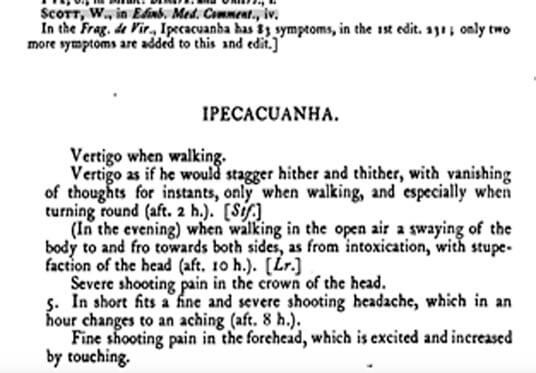
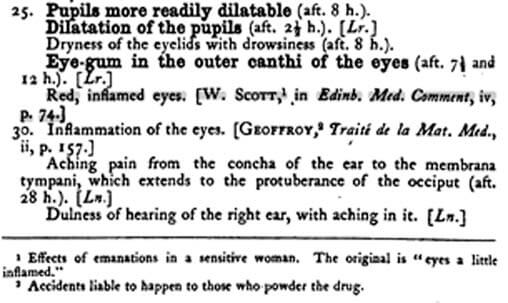
I will herein provide Scott’s account in full (pp.75-81).
“Mrs. S … of Stramfordham in Northumberland, married a person of the medical faculty in the year 1759, being then about 26 years of age. She had been always remarkably healthy before that period, and quite free from all nervous or other complaints, except a trifling headache that used to affect her temples and forehead, sometimes for a night or so, about the time of her menstruation.
The first year or two after her marriage, she enjoyed her usual good health and spirits in general; but sometimes she was afflicted with a very troublesome shortness of breathing, attended with a remarkable stricture about her throat and breast, and with a particular kind of wheezing noise. These fits came on suddenly, and without any exciting cause that at first could be assigned. They were often so violent as to threaten immediate suffocation. They lasted sometimes for a shorter, and sometimes for a longer time, but, in general, went off in two or three days, and commonly with a spitting of a tough phlegm, which she said had a disagreeable metallic taste. When these fits were off, she enjoyed her usual good health and spirits …
About a year and a half, or two years after her marriage, she told her husband that she had observed these fits had always attacked her when any ipecacuanha was powdered in his shop, and that she was certain the effluvia of the medicine immediately brought them on…when any of that medicine was powdering or putting up, she used immediately to call out, perhaps from a different room, that she found the Ipecacuanha, and that they would see her immediately affected by it …
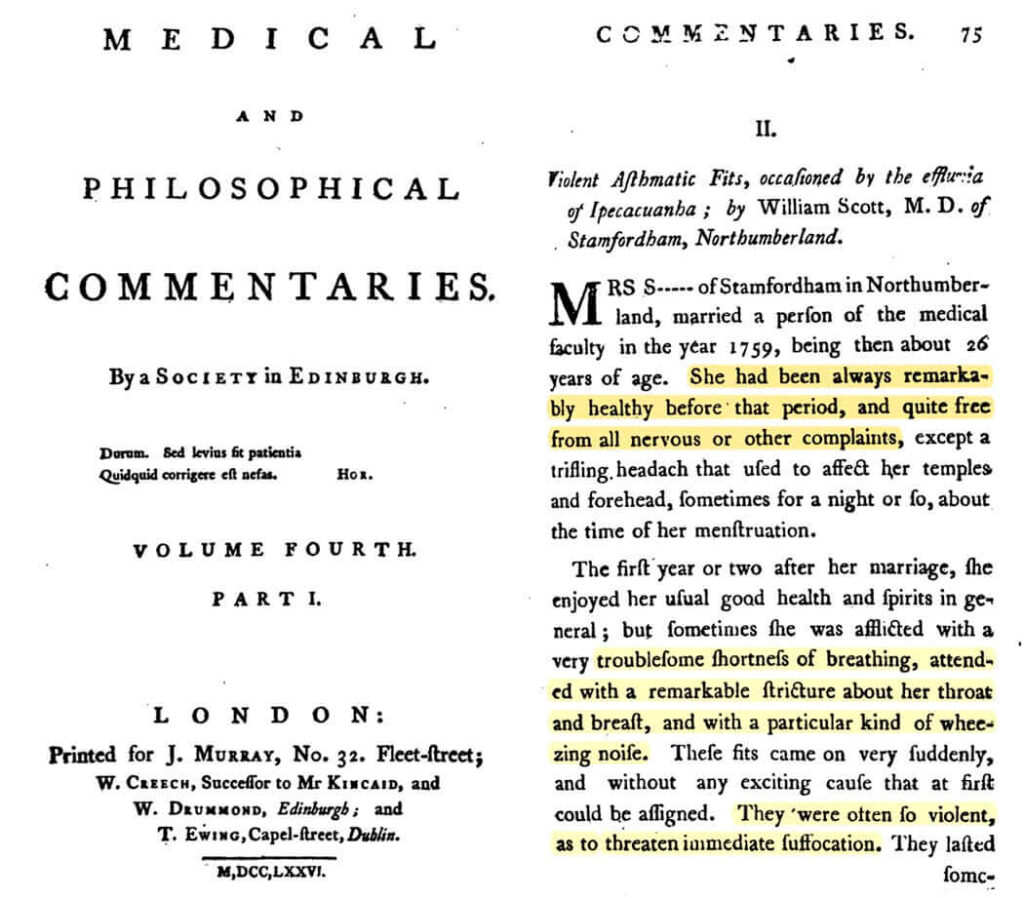
Betwixt nine and ten o‘clock in the evening June 3d 1775, her husband happening to have a quantity of the pulv. ipecacuanha home, without considering, opened it out, and put it into a bottle: His wife was not far off at the time, and then in perfect health. Almost before it was got quite put into the bottle, she called out that she felt the ipecacuanha affect her throat, on which she was immediately seized with a stricture upon her breast, and a difficulty of breathing. She was advised to walk out into the air, to try if that would put it off, but it had little or no effect; she went to bed some little time afterwards, was exceedingly ill all night, and betwixt two and three o’clock next morning I saw her, when she was gasping for breath at a window, was as pale as death, her pulse scarce to be felt, and, in short, seemed evidently to be in the utmost immediate danger of suffocation. She had seven or eight ounces of blood taken from her arm; her feet put into warm water; an anodyne draught, with seven or eight drops of laudanum, given her; and she took frequently a tablespoonful of oil of almonds. None of these seemed to have any effect, and she continued much in the same way, with a few or no intervals of ease, till about nine o’clock that morning; when, being in a manner almost exhausted, she fell into a kind of disturbed sleep, the difficulty of breathing, with a wheezing noise, still continuing but little abated. She slept some little time and got out of bed again about eleven o’clock that forenoon, her breathing still very difficult, and her eyes looked red and a little inflamed. After she got up, she became easier towards the afternoon, and it was then supposed it would go off…Towards bed-time the same evening, the difficulty of breathing returned, and she was again exceedingly ill all night; had flannel cloths wrung out of warm water applied to her feet, breast, and throat, with little or no advantage; was blooded again about seven o’clock next morning, and had also a blister applied to the back part of her neck; still continuing now and then a spoonful of the oil of almonds. She again fell upon some sleep about nine in the morning, and continued in bed till betwixt eleven and twelve; she got up, and was again a little easier during the day, but at night was as bad as ever. The same scene was continued for eight days and nights successively; that is, she was generally a little easier from about eleven o’clock in the forenoon, although still far from well, till towards ten or eleven o’clock at night, when the shortness of breathing always returned very violently. However, after eight days, she began to get some better rest at night; the asthmatic fits were neither so long nor so violent; and about fourteen days from the accident, they were almost entirely gone. Although she is now in very good health, she has not yet quite recovered her usual flesh, strength, and colour…She had a show of the menses four or five days after the accident, although it was then only the middle of the usual period; she coughed up at times some small quantities of blood, and had also some mixed with her stools and urine.
The reason why the laudanum, the most effectual and universal antispasmodic, was used in such small quantities, was, that it was known before, that she could never bear above eight or nine drops of it, as the common dose used to affect her with violent sickness at the stomach, giddiness, and pain in her head, to so great a degree, that, for some years past, she neither would take, nor durst her husband administer, a larger dose to her. At the time the above accident happened, she was not with child, nor had she had any for some years before …”2
From this account we may clearly comprehend the following 14 symptoms extracted by Hahnemann for placement into his pharmacography of Ipecacuanha and understand the actual series of effects of even a very small dose, via accidental olfaction, precipitated by this substance on a sufficiently predisposed individual:
- 29 Red, inflamed eyes. [W. Scott, in Edinb. Med. Comment, iv, p. 75.]
- 51 Spasmodic contractive sensation in the throat and on the chest. [Scott, l.c.]
- 108 Bloody stool. [Scott, l.c.]
- 115 Bloody urine. [Scott, l.c.]
- 122 Metrorrhagia – recurrence of the catamenia that had ceased fourteen days previously. [Scott, l.c.]
- 134 Spasmodic asthma with great contraction in the throat and chest, during which a peculiar kind of wheezing noise was heard. [Scott, l.c.] (In two women from the exhalation from the powder in a distant room; the illness lasted fourteen days.)
- 135 Sudden attacks of troublesome dyspnoea, with a wheezing noise in the air-tubes. [Scott, l.c.]
- 136 Contraction in the chest, with dyspnoea and wheezing respiration: she must go to the open window and gasp for air, with paleness of face, scarcely perceptible pulse, and danger of suffocation from the evening until 9 a.m. [Scott, l.c.]
- 137 Recurrence of the tightness of chest after twenty-four hours, from 10 p.m. until 10 a.m., for eight days. [Scott, l.c.]
- 138 Attack of suffocation for two or three days. [Scott, l.c.]
- 152 Cough with expectoration of a thick, disagreeably metallic tasting mucus. [Scott, l.c.]
- 153 Hæmoptysis. [Geoffroy,-Murray,-Scott, l.c.]
- 170 Debility. [Scott, l.c.]
- 175 Restless sleep. [Scott, l.c.]
Case Example3
Herein is a case of breath holding from the authors’ practice to illustrate the application of the law of similars from toxicology reports to symptom inclusion in the materia medicæ, to clinical application in praxis.
December 2012: A 21-month-old male presented to our clinic for parental concerns of frequent spells in which he would turn blue and lose consciousness. These episodes occurred several times per day and followed events in which he would get upset, such as when a toy was taken from him. He would stop breathing, arch his back and become rigid, his face would turn blue, and the boy would then pass out. His parents also noted that he perspired on his head during sleep and ate eggs daily. Physical exam revealed a large head for his age and a mild developmental delay in speech. After consulting with a pediatric neurologist, it was learned that these episodes were breath-holding spells, not seizures, and were due to emotional etiology.
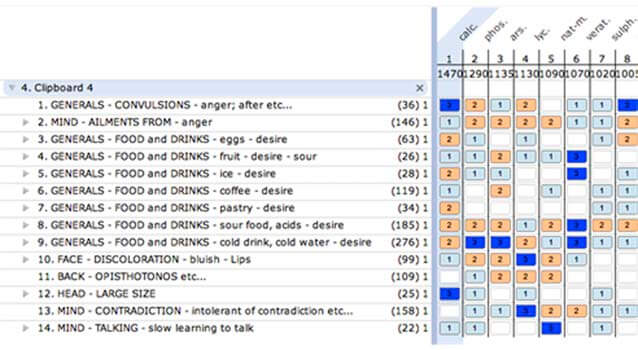
Using Schroyen’s Synthesis Treasure Edition 2009V in Radar Opus, a Kentian-based repertory, Calcarea carbonica 30c, daily dosing 3 dry pellets, was initially prescribed (see repertorization graph). Unfortunately, after the first follow up visit, it was clear that the patient did not respond to this medicine because the symptoms were unchanged.
This case was a good lesson for the author because, upon reviewing the primary text homoeopathic literature, it was clear that the original analysis included normal traits without focusing the case analysis on the symptoms relating directly to the deviations from health. Hahnemann discussed the subject in his Organon,4 §6:
“The unprejudiced observer … notices only the deviations from the former healthy state of the now diseased individual, which are felt by the patient himself, remarked by those around him and observed by the physician. All these perceptible signs represent the disease in its whole extent, that is, together they form the true and only conceivable portrait of the disease.”
Bönninghausen, on the same topic, wrote (BLW,5 pp. 232-33): “… [we must] not be so easily led astray by personal and individual traits. For the individual personality is often very different from the individual genius of the disease, and although the former may frequently cause a variance in the choice of the remedy nevertheless this selection must always be so made as to lie within the sphere of action of the genius of the disease.”
Therefore, the case was re-examined focusing solely on the symptoms of the disease state; the case was re-analyzed using the computerized version of Bönninghausen’s Therapeutic Pocketbook, through its most accurate English translation, TBR2.16 (see TBR 2.1 repertorization).

This repertorization pointed only to Nux vomica and Ipecacacuanha as covering all the symptom components necessary for the selection, and the uncommonness of Ipecacuanha being brought forward so clearly to our attention led the author to examine its primary proving record:
Ipecacacuanha, Hahnemann’s Materia Medica Pura [MMP]:7
Ipecacuanha preamble: “… spasmodic dyspnoea and suffocative spasms, …”
- 138 Attack of suffocation for two or three days. [Scott, l.c.]
- 142 Suffocative cough, during which the child becomes quite stiff and blue in the face (aft. 10 h.).
- 183 Symptoms of emprosthotonos and opisthotonos (aft. 10 h.).
- 184 The body of the child is stretched out stiffly.
- 185 Stiff extension of the whole body, followed by a spasmodic clapping together of the arms (after a quarter hour).
- 215 He has pleasure in nothing, nothing is agreeable to him.
- 224 He is morose and vexed that his business is not performed quick enough.
- 226 Extreme impatience.
- 227 He lets his courage sink, and is greatly given to be vexed and to get angry.
- 228 His disposition is full of wishes and longing he knows not for what.
- 229 He very often gets angry about the merest trifle, and can just as easily and quickly become calm (aft. 5 h.).
- 231 He is much inclined to become cross and angry.
Ipecacacuanha, from Allen’s Encyclopædia of Pure Materia Medica [AE]:8
“Instead of the ordinary wheezing, the muscles of respiration seemed tetanically convulsed, producing a condition not unlike what is denominated “holding the breath,” with slight sighs or catches at intervals barely sufficient to keep the wheels of life from ceasing altogether (in two instances) … “22c
22c Turner, Boston Medical & Surgical Journal, 1843, p.229 (2)
- This citation in AE is incorrect—the article appears on p.229 of vol.29, 1844 of the Boston Medical &Surgical Journal (actual “holding the breath” symptom is at the end of p.231-232).
Utilizing the HANP’s Dimitriadis Literature Collection online library, I was able to find this citation to Turner and have included pictures of the original journal with this citation from page 231 on the following page (see figure 4).
Ipecacuanha, from Hering’s The Guiding Symptoms of our Materia Medica [GS]:9
I. After chagrin, constant pressing pain in pit of stomach, loss of appetite, frequent nausea, eight days after this, in consequence of anger, sudden vomiting, first of clotted, then of fluid blood, amounting to about two pounds, deathly pale almost pulseless, faintness.
II. Ailments from vexation and reserved displeasure.
Ipecacuanha 30C, 3 dry pellets dissolved in mouth per day, was then prescribed based on the most characteristic symptoms of the case including: the episodes being triggered following vexation with indignation (3), turning blue (cyanotic), arrested respiration, and opisthotonos (rigid arching of the back).
- While we cannot trace this precise symptom of “vexation with indignation” to the primary text homoeopathic literature, Bönninghausen’s inclusion in the rubric along with supporting evidence from later authors (e.g., Hering) provides sufficient grounds for Ipecac’s inclusion under the “aggr. vexation” (TBR2 1762) and “aggr. vexation with indignation” (TBR2 1766) rubrics. It further illustrates the accuracy and dependability of information listed by Bönninghausen.
At the patient’s next follow-up visit, the parents reported that he had not had any episodes of breath-holding spells in the past 10 weeks. They explained that when he became upset, he would look like he typically does during a spell, but the symptoms did not progress to a breath-holding spell. Since the patient was continuing to react positively to Ipecacuanha 30C, the remedy was continued for another 10 weeks. At the next follow-up visit, the parents reported he had one breath-holding episode. The potency of Ipecacuanha was then increased to 200C, 3 pellets dissolved in mouth daily. The patient continued to react positively to the medicine, the breath-holding spells became extremely rare. The author has seen the father recently who reported that the boy’s breath-holding spells remain resolved.
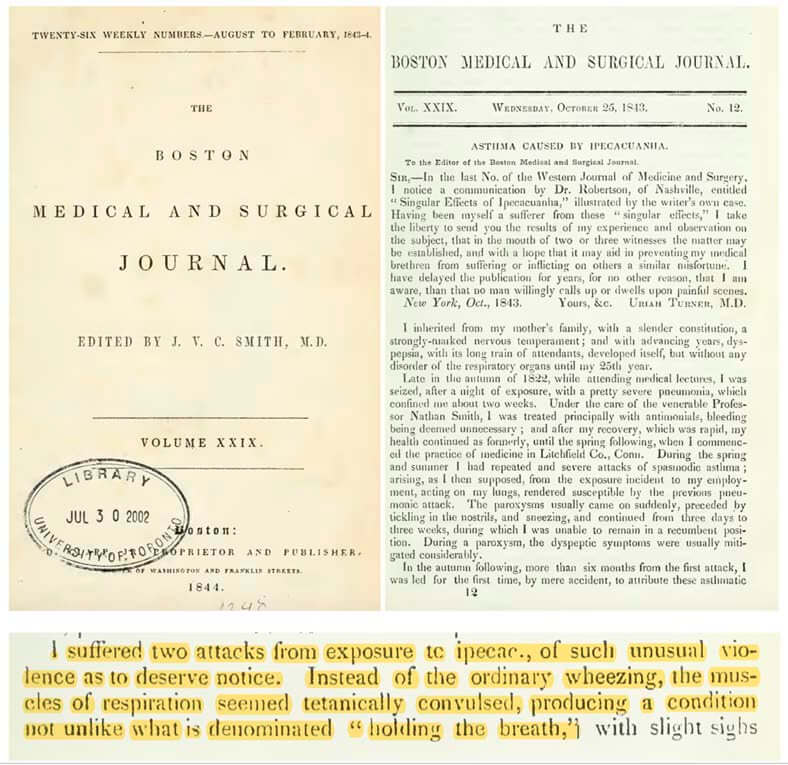
Conclusion
The September 2024 collaborative conference will offer insight into the development of Hahnemann’s methodical approach to the acquisition of knowledge of substance effects (substance trials, provings) and how he married these with existing toxicological reports selectively recruited from old (allopathic) school sources, resulting in an unmatched ‘synergy’ of speculation-free, determinate substance effects, culminating in the publishing of his materia medicae (study of our pharmacography). The conference will include practical case exercises to enhance attendees’ learning experience with skill building exercises to search for toxicological reports in the HANP’s Dimitriadis Literature Collection open access online library housed by Sonoran University. Attendees will then practice critically examining these old school toxicological reports to apprehend Hahnemann’s inclusion of symptoms into his materia medicæ, gaining a new appreciation and understanding of the homoeopathic medicines.
Secondly, we will also examine the tools developed to facilitate our application of ‘omoion’ (similars), with a brief history leading up to the development of the most compact and accurate repertory, Bönninghausen’s Therapeutisches Pocketbook, being the repertorial work most closely reflecting Hahnemann’s own teachings. The series of lectures will include case exercises and examples demonstrating the use of Bönninghausen’s repertorial method. (study of our repertography)
This unified and cohesive course prospectus will be taught by a team of expert teachers, including a homoeopathic veterinarian, who have been highly trained after the methodology of Hahnemann and Bönninghausen. Attendees will be able to immediately apply the tools and skills gained from this active hands-on learning conference to their own practice for greatly improved clinical outcomes.
We hope that this conference will inspire a new generation of homoeopaths to utilize this online library and create a renaissance of interest in this literature that can be used for a wide variety of purposes, such as personal study, group materia medica study groups, research to update and correct our materia medicæ sources, publications, or even future conferences on related topics, and much more.
We are looking forward to seeing you there!
 About the author: Dr. Jamie Oskin, ND, is in private practice in Phoenix, AZ and is adjunct faculty at Southwest College of Naturopathic Medicine. He completed a homoeopathic selective residency at the Southwest Naturopathic Medical Center. Read more at www.AzNaturalHealth.com.
About the author: Dr. Jamie Oskin, ND, is in private practice in Phoenix, AZ and is adjunct faculty at Southwest College of Naturopathic Medicine. He completed a homoeopathic selective residency at the Southwest Naturopathic Medical Center. Read more at www.AzNaturalHealth.com.
References
- Dimitriadis G.: Materia Medica Hahnemannica – A Compendium of Hahnemann’s Pharmacographic Record faithfully renewed with retranslations and corrections with reference to original sources, 2006, HISydney—This ongoing work remains unpublished.
- Scott, William: Violent Asthmatic Fits, occasioned by the effluvia of Ipecacuanha, Edinburgh Medical and Philosophical Commentaries, Edinburgh, 1776, vol.4, pp.75-81.
- Case originally published in the following article: Oskin, J, Wheeler, M, Messer, S: “Clarifying Vexation, A Historically Misunderstood Concept,” The American Homeopath, Vol. 22, pp. 89-98, 2016.
- Hahnemann, Samuel: Organon of Medicine, Arnold, Dresden & Leipzig, 1833, 5th ed. Translated by Dudgeon, R.E., London, 1849. Reprint, B. Jain Publishers, New Delhi, 1996.
- Bönninghausen, CMF von: The Lesser Writings of CMF von Boenninghausen, compiled by Thomas Lindsley Bradford, translated from the original German by by L.H. Tafel, Philadelphia, 1908, pp.232-233. Reprint B. Jain Publishers, Delhi, 2005 [BLW].
- Dimitriadis G.: The Bönninghausen Repertory-therapeutic pocket book method, Hahnemann Institute Sydney, 2010, 2nd edition [TBR2]. Analyses shown using TBR2.1 software version (of TBR2) which is now available as cloud based online platform, available by annual/monthly subscription.
- Hahnemann, Samuel: Reine Arzneimittellehre [RA], Arnold, Dresden & Leipzig, 1825-1833 [3rd ed. vols. 1-2; 2nd ed. vols. 3-6]. Also available in facsimile reprint, Haug, Ulm/Donau, 1955. Translated by Dudgeon, R.E.: Materia Medica Pura, [MMP], RA English translation, 1880. Reprint, B. Jain, Delhi, 1990.
- Allen, T.F. Encyclopædia of Pure Materia Medica, A Record of the Positive Effects of Drugs Upon the Healthy Human Organism [1874] [AE]. Indian Reprint, New Delhi: B. Jain Publishers; 2000.
- Hering, C.: The Guiding Symptoms of Our Materia Medica, Philadelphia, 1891, vol.10. Reprint, B. Jain Publishers, New Delhi, 1997
About the AJHM
The American Journal of Homeopathic Medicine (AJHM) is a peer-reviewed scientific journal, specifically intended to meet the needs of physicians involved in the specialty of homeopathy. The editor invites original manuscripts, feature articles, research reports, 'Homeopathic Grand Rounds' cases studies, abbreviated case reports for 'Clinical Snapshots,' seminar reports, and position papers that focus on homeopathy, as well as book reviews and letters to the editor. Click below to subscribe to the Journal.
Latest Issue of the AJHM

AJHM – Spring 2025
Volume 118 Number 1
Table of Contents
- Editorial: In this issue
- President’s Message: Our Guiding Precepts
- Homeopathic PuZZle?
- Alchemy, Spagyrics, and Homeopathy: Tracing the Threads of Energetic Medicine
- The Genius of Fluoricum acidum: Part One
- An Interesting Case of Kola
- Book Review: ‘Lessons in Pure Homeopathy, From the Writings of Hahnemann’s Best Student and Medicine’s Most Successful Practitioner, Adolph Lippe, MD’ – Edited & Annotated by A. Saine, ND
- Book Review: ‘Folkways and Homoeopathy: Our Ancestral Secret of Healing’ by Shailendra Ramchandra Vaishampayan


